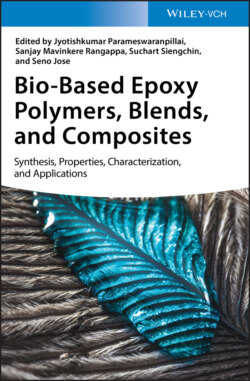Читать книгу Bio-Based Epoxy Polymers, Blends, and Composites - Группа авторов - Страница 10
Preface
ОглавлениеEpoxy polymers are thermosetting polymers widely used in construction and building, automobile, aerospace, and marine industries. However, traditional epoxy systems are nonbiodegradable and cannot be recycled. The plastic waste is generating at an alarming rate and only 9% is recycled, and the remaining 91% is either landfilled or dumped in the natural environment. Moreover, plastic waste accumulation in the seawater, especially in the Pacific Ocean, is increasing at an alarming rate. Therefore, researchers and scientists are concentrating to develop biodegradable polymers. One of the inventions in this area is the production of bioepoxy resins from different plant sources. A surge in the production of bioepoxy resins was observed in the past decade. The polymer manufacturers (Sicomin, Gougeon Brothers, Wessex Resins, Bitrez, etc.) are now producing bioepoxy resins. Generally, bioepoxy resins are brittle, which limits their application in advanced composite industries. Studies have shown that the incorporation of fillers/fibers can significantly enhance the thermomechanical, electrical, and other physical properties of the bioepoxy composites. The high acceptance level of bioepoxy resins in automobile, aerospace, construction, and marine industries all across the world is expected to increase the production of bioepoxy resins in the coming years.
The research in the field of bioepoxy resins and their blends and composites are flourishing. This leads to an upsurge in the number of publications. However, no books have been published in the area of bioepoxy resins. Therefore, we believe that it is important to edit a book on “Bio‐Based Epoxy Polymers, Blends, and Composites: Synthesis, Properties, Characterization, and Applications.” We hope that the present book will benefit scientists, engineers, academic staff, and students working in the area of bio‐based epoxy polymers, blends, and composites.
This book consists of 12 chapters that describe “Bio‐Based Epoxy Polymers, Blends, and Composites: Synthesis, Properties, Characterization, and Applications.” The chapter “Synthesis of Bioepoxy Resins” summarizes the synthesis of fully bio‐based epoxy resins, their properties, and potential uses. The chapter “Natural/Synthetic Fiber‐Reinforced Bioepoxy Composites” focuses on the different bioepoxy resins and natural/synthetic fiber‐reinforced bioepoxy composites, their mechanical properties, and applications. The chapter “Polymer Blends Based on Bioepoxy Polymers” reviews the preparation of bio‐based epoxy blends for various applications. The chapter “Cure Kinetics of Bioepoxy Polymers, Their Blends, and Composites” emphasizes the importance of kinetics studies of the bioepoxy/hardener reaction. The chapter “Rheology of Bioepoxy Polymers, Their Blends, and Composites” discusses the role of rheological studies on the processing of the bioepoxy composites. The chapter “Dynamical Mechanical Thermal Analysis of Bioepoxy Polymers, Their Blends, and Composites” describes the viscoelastic properties of bioepoxy blends and composites. The chapter “Mechanical Properties of Bioepoxy Polymers, Their Blends, and Composites” discusses the factors influencing the mechanical aspects of bioepoxy composites. The chapter “Bioepoxy Polymer, Blends, and Composites Derived Utilitarian Electrical, Magnetic, and Optical Properties” reviews the electrical, electronic, magnetic, and optical properties of bioepoxy systems. The chapter “Spectroscopy and Other Miscellanies Techniques for the Characterization of Bioepoxy Polymers, Their Blends, and Composites” gives an overview of the characterization of bioepoxy systems using various techniques such as Fourier transform infrared spectroscopy, nuclear magnetic resonance spectroscopy, differential scanning calorimetry, and thermogravimetric analysis. The chapter “Flame Retardancy of Bioepoxy Polymers, Their Blends, and Composites” highlights the recent developments in flame‐retardant bio‐based epoxy resins. The chapter “Water Sorption and Solvent Sorption of Bioepoxy Polymers, Their Blends, and Composites” focuses on the water absorption properties of bioepoxy systems. The chapter “Bio‐Based Epoxy: Applications in Mendable and Reprocessable Thermosets, Thermosetting Foams, and Pressure‐Sensitive Adhesives” give an overview of the recent developments in self‐healing bioepoxy systems and bio‐based epoxy foams.
The editors are thankful to the contributors of all chapters and the Wiley editorial and publishing team for their kind support. The editors are also thankful to Ms. Junjiraporn Thongprasit (Baifern) for her involvement at the initial screening process of chapters.
20 August 2019
Dr. Jyotishkumar Parameswaranpillai (Thailand)
Dr. Sanjay Mavinkere Rangappa (Thailand)
Prof. Dr.-Ing. habil. Suchart Siengchin (Thailand)
Dr. Seno Jose (India)
